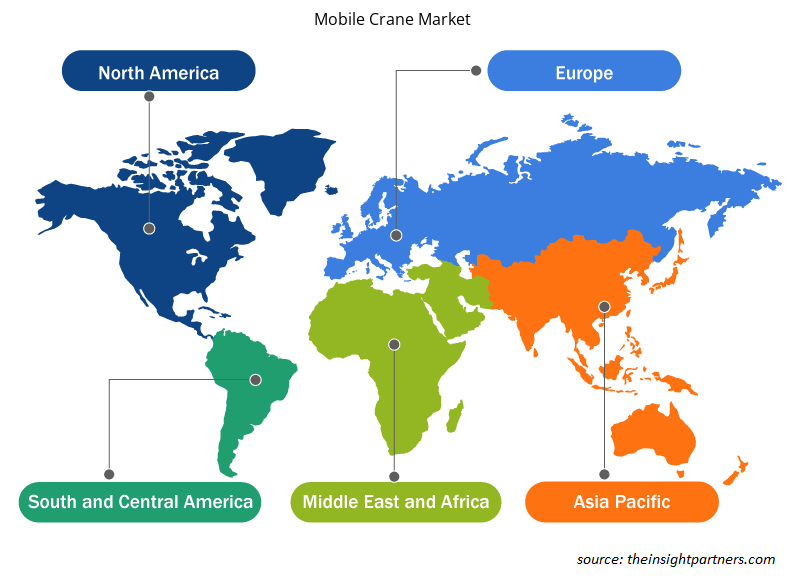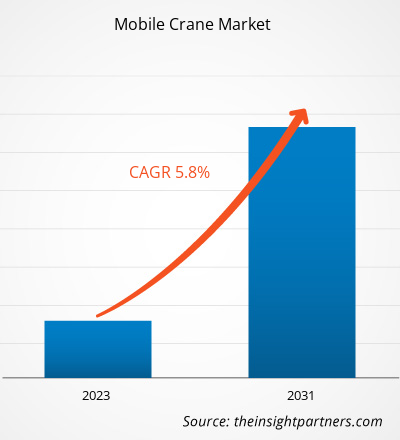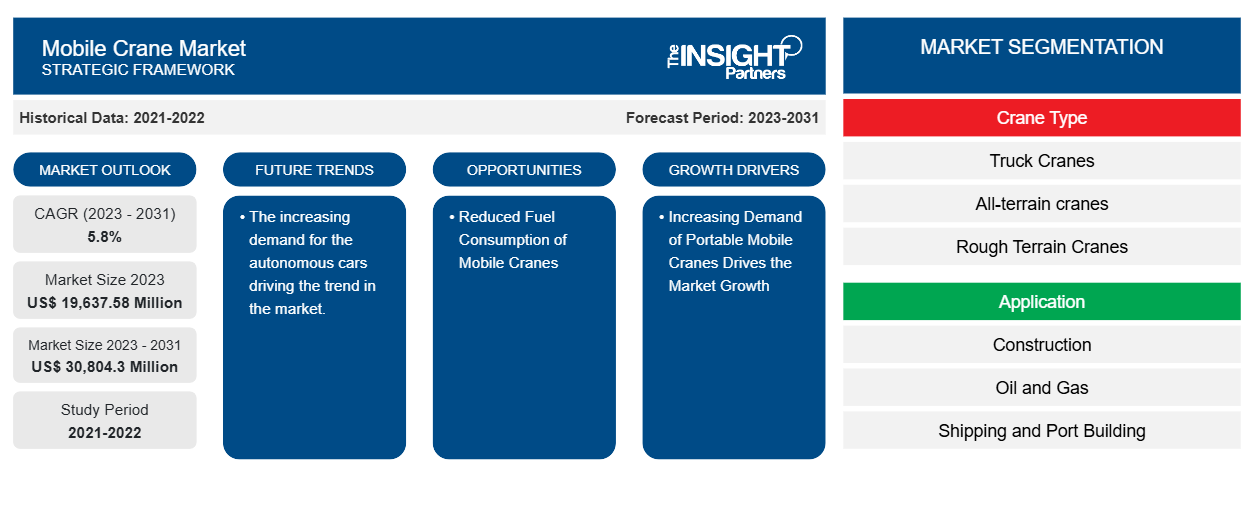Der Markt für Mobilkräne soll von 19.637,58 Millionen US-Dollar im Jahr 2023 auf 30.804,3 Millionen US-Dollar im Jahr 2031 anwachsen. Der Markt soll zwischen 2023 und 2031 eine durchschnittliche jährliche Wachstumsrate (CAGR ) von 5,8 % verzeichnen. Die zunehmenden Bauaktivitäten auf der ganzen Welt treiben den Trend auf dem Markt voran.
Marktanalyse für Mobilkräne
OEMs auf dem globalen Markt für Mobilkräne führen verschiedene Prozesse aus, wie etwa Design, Montage und Umwandlung von Rohmaterial in fertige Produkte. Liebherr-International S.A. ; Terex Corporation; Tadano Ltd.; Zoomlion Heavy Industry Science and Technology Co. Ltd.; XCMG Construction Machinery Co., Ltd.; SANY Heavy Industry Co., Ltd. Kato Works Co. Ltd.; KOBELCO Construction Machinery Co., Ltd.; Hitachi Sumitomo Heavy Industries Construction Crane Co., Ltd.; The Manitowoc Company, Inc. sind unter anderem einige der führenden Anbieter auf dem Markt für Mobilkräne. Die Unternehmen bieten eine breite Produktpalette an, darunter Autokräne, All-Terrain-Kräne, Rough-Terrain-Kräne, Raupenkräne und mehr.
Marktübersicht für Mobilkräne
Das Ökosystem des Mobilkranmarktes umfasst die folgenden Interessengruppen: Rohstoffanbieter, Hersteller von Mobilkrankomponenten, OEMs und Endverbraucher. Wichtige Akteure nehmen wichtige Plätze in den verschiedenen Knotenpunkten des Mobilkranmarktökosystems ein. Die Rohstoffanbieter liefern die Komponenten wie Stahlplatten und auf Länge geschnittene Standard-Strukturrohre, aus denen Schweißer Strukturen herstellen. Die verschiedenen Unterbaugruppen werden alle in ein zentrales Fließband für einen bestimmten Krantyp und ein bestimmtes Kranmodell eingespeist. Am Fließband werden Stahlkomponenten zusammengefügt, Elektronik hinzugefügt und, je nach den Spezifikationen des jeweiligen Krans, weitere Komponenten oder Zubehörteile hinzugefügt. Die Komponentenhersteller liefern unter anderem Haken, Hebezeuge, Laufkatzen, Brücken, Lastmesssysteme und Hebemagnete für die Kräne.
Passen Sie diesen Bericht Ihren Anforderungen an
Sie erhalten kostenlos individuelle Anpassungen an jedem Bericht, einschließlich Teilen dieses Berichts oder einer Analyse auf Länderebene, eines Excel-Datenpakets sowie tolle Angebote und Rabatte für Start-ups und Universitäten.
-
Holen Sie sich die wichtigsten Markttrends aus diesem Bericht.Dieses KOSTENLOSE Beispiel umfasst eine Datenanalyse von Markttrends bis hin zu Schätzungen und Prognosen.
Treiber und Chancen auf dem Mobilkranmarkt
Steigende Nachfrage nach tragbaren Mobilkränen treibt das Marktwachstum an
Der grundlegende Vorteil von Mobilkränen ist ihre Kompaktheit und leichte Zugänglichkeit auf kleinen Baustellen, insbesondere in städtischen Gebieten. Mobilkräne benötigen weniger Platz als Turmdrehkräne und erfüllen dieselben Aufgaben wie stationäre Kräne. Darüber hinaus müssen transportable Kräne nicht an jedem Standort aufgebaut werden, was Zeit spart und den Arbeitsaufwand verringert. Liebherr stellte im März 2021 den Mobilbaukran MK 73-3.1 vor, den kleinsten der Mobilbaukranfamilie von Liebherr . Das neue Produkt ergänzt die Kranserie des Unternehmens, zu der der MK 88-4.1 und der MK 140 gehören. Der kompakte 3-Achs-Kran der Unternehmen ist die Antwort des Marktes auf den Wunsch nach einem winzigen, kompakten und wendigen Mobilbaukran, der schnell und vielseitig einsetzbar ist. Solche Entwicklungen in den Funktionalitäten treiben das Wachstum des Mobilkranmarktes voran.
Aufbau eines großen Intralogistikzentrums in Südostasien
Der wachsende E-Commerce-Sektor in Südostasien unterstützt die Expansion des Marktes für Lagerhaltung und Intralogistik in dieser Region. Die Region umfasst 11 Ländermärkte mit unterschiedlichem Wachstumsniveau und entwickelt sich daher schnell zu einem Wirtschaftszentrum . Die Wirtschaft der südostasiatischen Länder wächst mit der stetig wachsenden Mittelschicht. Laut Statistiken des Internationalen Währungsfonds wird das Gesamt-BIP aller ASEAN -Länder bis 2024 voraussichtlich 4,37 Billionen US-Dollar betragen.
Reduzierter Kraftstoffverbrauch von Mobilkränen
Der wachsende Trend zu leistungsstarken Produkten mit Kraftstoffeffizienz und reduziertem CO2-Ausstoß hat die Unternehmen auf dem Markt für Mobilkräne dazu ermutigt, ihr Produktportfolio zu erneuern und ihre Präsenz in der schnell wachsenden Kategorie der Autokräne zu stärken. Daher hat Sany Heavy Industry India pt. Ltd. seine modernen, abgaskonformen Kräne der Stufe IV von CEV auf den Markt gebracht , die weniger Strom verbrauchen und im Betrieb Stabilität und Sicherheit bieten. Die maximale Tragfähigkeit dieses modernen Krans beträgt 25 Tonnen bei einem Arbeitsradius von 3 m und einer maximalen Auslegerlänge von 33,5 m. Der STC450C ist kraftstoffeffizient und verfügt über ein einstellbares Hydrauliksystem mit intelligenter elektrischer Steuerung . Durch die zunehmende Zahl von Infrastrukturprojekten weltweit ist die Nachfrage nach Kränen mit modernen mechanisierten Lösungen, hoher Tragfähigkeit, geringem Kraftstoffverbrauch und einfacher Wartung gestiegen.
Modelle von Mobilkränen verfügen jetzt über Antriebs- und Steuerungssysteme mit einer Vielzahl optionaler Funktionen, die dazu beitragen, den Kraftstoffverbrauch zu minimieren und die Produktivität und Zuverlässigkeit zu erhöhen. Wenn sich der Motor im Leerlauf befindet, wird der gesamte Pumpenantrieb automatisch ausgekuppelt, und wenn Strom benötigt wird, wird er mithilfe einer intelligenten Steuerung innerhalb weniger Sekunden eingeschaltet. Die Software liefert Signale an den elektronischen Motor, der seine Drehzahl automatisch entsprechend den Hebeanforderungen auf der Baustelle anpasst. Zoomlion stellt beispielsweise Mobilkräne her, die über ein Energiesparsystem verfügen, das in mehreren Leistungsmodi arbeitet und den durchschnittlichen Kraftstoffverbrauch um 20 % auf 4,5 Liter pro Stunde reduziert hat. Zoomlion hat außerdem die Kabinen und das Bedienerinformationsfeld des Krans so ergonomisch und sicher wie möglich gestaltet, um so die potenzielle Nachfrage aus Übersee zu maximieren.
Segmentierungsanalyse des Marktberichts für Mobilkräne
Wichtige Segmente, die zur Ableitung der Marktanalyse für Mobilkräne beigetragen haben, sind Krantyp, Anwendung und Geografie.
- Basierend auf dem Krantyp ist der globale Markt für Mobilkrane in Autokrane, All-Terrain-Krane, Geländekrane, Raupenkrane und andere unterteilt. Das Segment der Autokrane hatte 2020 den größten Marktanteil. Das Segment der All-Terrain-Krane wird im Prognosezeitraum voraussichtlich mit der höchsten durchschnittlichen jährlichen Wachstumsrate wachsen. All-Terrain-Krane, insbesondere im Bereich von 100 bis 250 Tonnen, sind aufgrund ihrer Kapazität und Flexibilität am gefragtesten.
- Basierend auf der Anwendung ist der globale Markt für Mobilkrane in Bauwesen, Öl und Gas, Schifffahrt und Hafenbau, Energie und Versorgung und andere unterteilt. Das Bausegment hatte im Jahr 2020 den größten Marktanteil. Das Öl- und Gassegment wird im Prognosezeitraum voraussichtlich mit der höchsten durchschnittlichen jährlichen Wachstumsrate wachsen. Offshore-Mobilkrane werden zunehmend für die Öl- und Gasförderung eingesetzt.
Marktanteilsanalyse für Mobilkräne nach Geografie
Der geografische Umfang des Marktberichts für Mobilkräne ist hauptsächlich in fünf Regionen unterteilt: Nordamerika, Asien-Pazifik, Europa, Naher Osten und Afrika sowie Süd- und Mittelamerika.
Der asiatisch-pazifische Raum ist aufgrund der weltweit zunehmenden Bautätigkeit die am schnellsten wachsende Region. Darüber hinaus wird der europäische Markt für Mobilkrane in erster Linie durch einen erheblichen Anstieg der Vermietung und des Leasings von Baumaschinen sowie durch die Ausbreitung des Bausektors auf dem gesamten Kontinent angetrieben. Dies hat es Endverbrauchern erleichtert, auf Baumaschinen zuzugreifen und sie für eine breite Palette von Anwendungen zu nutzen. Darüber hinaus gehörten die USA zu den Ländern, die am stärksten von der Pandemie betroffen waren. Laufende Infrastrukturprojekte und Baustellen wurden während dieser Zeit gestoppt; dies hatte erhebliche Auswirkungen auf den Markt für Mobilkrane. Kurz nach dem dritten Quartal 2021 hoben die Regierungen mehrere Vorschriften und Maßnahmen auf, um die Verluste des nordamerikanischen Mobilkranmarktes zu überwinden.
Regionale Einblicke in den Mobilkranmarkt
Die regionalen Trends und Faktoren, die den Markt für Mobilkräne im Prognosezeitraum beeinflussen, wurden von den Analysten von Insight Partners ausführlich erläutert. In diesem Abschnitt werden auch die Marktsegmente und die Geografie für Mobilkräne in Nordamerika, Europa, im asiatisch-pazifischen Raum, im Nahen Osten und Afrika sowie in Süd- und Mittelamerika erörtert.

- Erhalten Sie regionale Daten zum Mobilkranmarkt
Umfang des Marktberichts für Mobilkräne
| Berichtsattribut | Details |
|---|---|
| Marktgröße im Jahr 2023 | 19.637,58 Millionen US-Dollar |
| Marktgröße bis 2031 | 30.804,3 Millionen US-Dollar |
| Globale CAGR (2023 - 2031) | 5,8 % |
| Historische Daten | 2021-2022 |
| Prognosezeitraum | 2023–2031 |
| Abgedeckte Segmente |
Nach Krantyp
|
| Abgedeckte Regionen und Länder |
Nordamerika
|
| Marktführer und wichtige Unternehmensprofile |
|
Marktteilnehmerdichte: Der Einfluss auf die Geschäftsdynamik
Der Markt für Mobilkräne wächst rasant, angetrieben durch die steigende Nachfrage der Endnutzer aufgrund von Faktoren wie sich entwickelnden Verbraucherpräferenzen, technologischen Fortschritten und einem größeren Bewusstsein für die Vorteile des Produkts. Mit steigender Nachfrage erweitern Unternehmen ihr Angebot, entwickeln Innovationen, um die Bedürfnisse der Verbraucher zu erfüllen, und nutzen neue Trends, was das Marktwachstum weiter ankurbelt.
Die Marktteilnehmerdichte bezieht sich auf die Verteilung der Firmen oder Unternehmen, die in einem bestimmten Markt oder einer bestimmten Branche tätig sind. Sie gibt an, wie viele Wettbewerber (Marktteilnehmer) in einem bestimmten Marktraum im Verhältnis zu seiner Größe oder seinem gesamten Marktwert präsent sind.
Die wichtigsten auf dem Markt für Mobilkräne tätigen Unternehmen sind:
- Liebherr-International SA
- Terex Corporation
- Tadano Ltd.
- Zoomlion Schwerindustrie Wissenschaft und Technologie Co. Ltd.
- XCMG Baumaschinen Co., Ltd.
- SANNY Heavy Industry Co., Ltd. Kato Works Co., Ltd.
Haftungsausschluss : Die oben aufgeführten Unternehmen sind nicht in einer bestimmten Reihenfolge aufgeführt.

- Überblick über die wichtigsten Akteure auf dem Mobilkranmarkt
Neuigkeiten und aktuelle Entwicklungen auf dem Mobilkranmarkt
Der Markt für Mobilkräne wird durch die Erhebung qualitativer und quantitativer Daten nach Primär- und Sekundärforschung bewertet, die wichtige Unternehmensveröffentlichungen, Verbandsdaten und Datenbanken umfasst. Nachfolgend sind einige der Entwicklungen auf dem Markt für Mobilkräne aufgeführt:
- ACE - Action Construction Equipment (ACE) hat den ersten vollelektrischen Mobilkran mit 180 Tonnen Tragkraft auf den Markt gebracht. Es ist die erste Hubarbeitsbühne, die auf der Bauma Conexpo 2023 vorgestellt wird. (Quelle: Unternehmenswebsite, Februar 2024)
- Die Firmengruppe Liebherr plant, ein weiteres Kranmodell mit der neuen Steuerung LICCON3 auf den Markt zu bringen: Aus dem LTM 1300-6.3 wird der LTM 1300-6.4. Damit zeichnen sich nun drei Modelle der LTM-Reihe durch das neue, richtungsweisende Krandesign des Unternehmens aus. Liebherr präsentiert den LTM 1300-6.4 auf der Intermat in Paris, Frankreich. (Quelle: Firmenwebsite, März 2024)
Marktbericht zu Mobilkränen – Umfang und Ergebnisse
Der Bericht „Marktgröße und Prognose für Mobilkrane (2021–2031)“ bietet eine detaillierte Analyse des Marktes, die die folgenden Bereiche abdeckt:
- Marktgröße und Prognose für Mobilkrane auf globaler, regionaler und Länderebene für alle wichtigen Marktsegmente, die im Rahmen des Berichts abgedeckt sind
- Markttrends für Mobilkräne sowie Marktdynamik wie Treiber, Einschränkungen und wichtige Chancen
- Detaillierte PEST- und SWOT-Analyse
- Analyse des Mobilkranmarkts mit Blick auf wichtige Markttrends, globale und regionale Rahmenbedingungen, wichtige Akteure, Vorschriften und aktuelle Marktentwicklungen
- Branchenlandschaft und Wettbewerbsanalyse, einschließlich Marktkonzentration, Heatmap-Analyse, prominenten Akteuren und aktuellen Entwicklungen auf dem Markt für Mobilkräne
- Detaillierte Firmenprofile
- Historische Analyse (2 Jahre), Basisjahr, Prognose (7 Jahre) mit CAGR
- PEST- und SWOT-Analyse
- Marktgröße Wert/Volumen – Global, Regional, Land
- Branchen- und Wettbewerbslandschaft
- Excel-Datensatz
Aktuelle Berichte
Verwandte Berichte
Erfahrungsberichte
Grund zum Kauf
- Fundierte Entscheidungsfindung
- Marktdynamik verstehen
- Wettbewerbsanalyse
- Kundeneinblicke
- Marktprognosen
- Risikominimierung
- Strategische Planung
- Investitionsbegründung
- Identifizierung neuer Märkte
- Verbesserung von Marketingstrategien
- Steigerung der Betriebseffizienz
- Anpassung an regulatorische Trends























 Kostenlose Probe anfordern für - Markt für Mobilkräne
Kostenlose Probe anfordern für - Markt für Mobilkräne